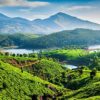Nestled amidst the lush Western Ghats, Wayanad emerges as a verdant paradise, beckoning travelers with its captivating blend of natural beauty, cultural richness, and adventurous spirit. This enchanting district in Kerala, often referred to as the “Land of Paddy Fields,” boasts a captivating landscape that encompasses mist-clad mountains, cascading waterfalls, serene lakes, and spice-scented plantations.
A Tapestry of Green:
Wayanad’s allure begins with its sprawling expanse of greenery. The region is home to several wildlife sanctuaries, including the Wayanad Wildlife Sanctuary, which shelters a diverse range of flora and fauna. Embark on a jeep safari or a guided trek through the sanctuary’s dense forests and you might encounter elephants, tigers, leopards, and various species of deer.
The Tholpetty Wildlife Sanctuary, located in the northern part of Wayanad, offers another opportunity to witness the region’s biodiversity. The sanctuary is home to a significant population of elephants, as well as other mammals like sloth bears, wild dogs, and various primates.
Waterfalls and Lakes:
Wayanad is blessed with numerous waterfalls that cascade down rocky slopes, adding to the region’s scenic charm. The Soochipara Falls, also known as the Sentinel Rock Waterfalls, are a popular attraction for adventure enthusiasts. The three-tiered waterfalls offer a challenging trek and a refreshing dip in the cool waters.
The Meenmutty Falls, located near the Banasura Sagar Dam, are another picturesque waterfall that requires a bit of a trek to reach. The falls are nestled amidst dense forests, creating a serene atmosphere that’s perfect for unwinding.
The Pookode Lake, a natural freshwater lake, is a tranquil spot for boating and enjoying the scenic surroundings. The lake is surrounded by lush greenery and is home to a variety of aquatic life.
Ancient Caves and Tribal Heritage:
Wayanad’s history dates back to ancient times, as evidenced by the Edakkal Caves. These caves, located on Ambukuthi Hill, contain Neolithic-era carvings and paintings that provide a glimpse into the region’s prehistoric past. The trek to the caves is an adventure in itself, offering stunning views of the surrounding valleys.
Wayanad is also home to several indigenous tribes, each with its own unique culture and traditions. The Kurichiya and Kuruma tribes are known for their distinctive lifestyle and rich folklore. Interacting with these tribes offers a fascinating insight into their way of life and customs.
Spice Plantations and Coffee Estates:
Wayanad’s fertile soil and favorable climate make it an ideal region for cultivating spices and coffee. The region’s spice plantations are a sensory delight, with the aroma of cardamom, pepper, cloves, and cinnamon filling the air. Take a guided tour of a spice plantation to learn about the cultivation process and sample freshly harvested spices.
The coffee estates of Wayanad are equally captivating. The rolling hills covered in coffee bushes create a picturesque landscape that’s a photographer’s dream. You can visit a coffee estate to learn about the coffee-making process, from bean to cup, and savor the rich flavors of Wayanad coffee.
Adventure and Beyond:
Wayanad’s natural beauty and diverse terrain make it an ideal destination for adventure activities. Trekking, camping, rock climbing, and rappelling are popular options for adrenaline junkies. The Banasura Sagar Dam, the largest earthen dam in India, offers opportunities for boating and kayaking.
For those seeking a more relaxed experience, Wayanad offers plenty of options for unwinding. You can enjoy a leisurely stroll through the tea gardens, visit a local market to shop for handicrafts and spices, or simply relax in your resort and soak in the tranquility of the surroundings.
A Destination for All Seasons:
Wayanad’s pleasant climate makes it a year-round destination. The summer months (March to May) are ideal for trekking and outdoor activities, while the monsoon season (June to September) brings the landscape to life with its lush greenery and gushing waterfalls. The winter months (October to February) are perfect for enjoying the cool weather and exploring the region’s cultural attractions.






